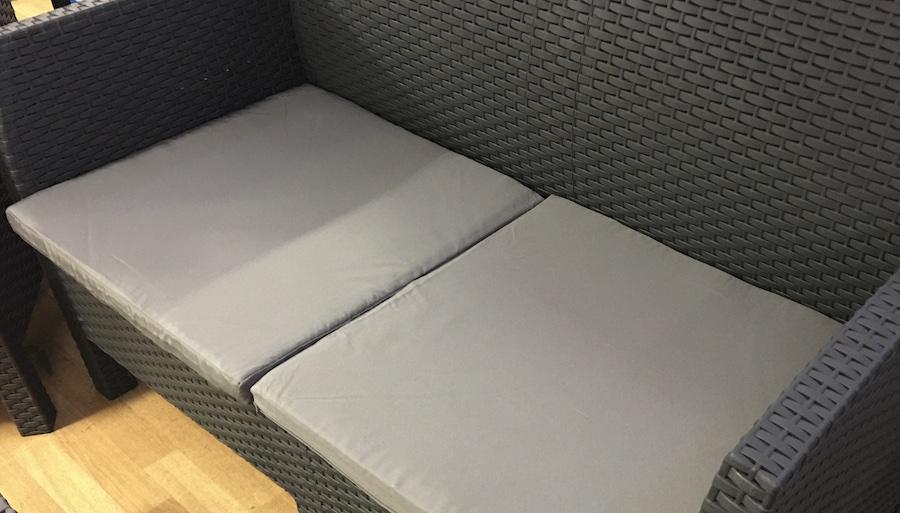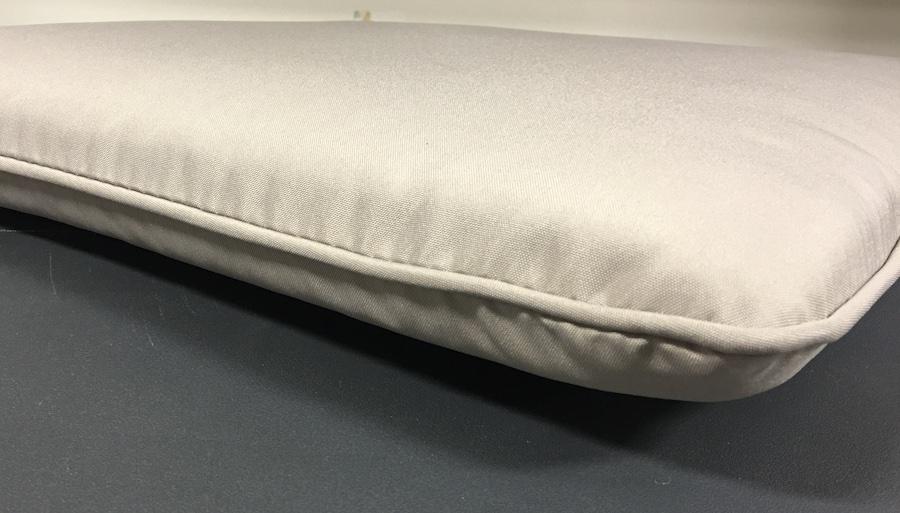Bench cushioning is not only beneficial in terms of turning your hard, uncomfortable furniture into a comfortable and relaxing place to sit but also great for turning a dull seating space into something more stylish. But what foam is best for bench cushions to help make this space great?
Every individual has a different taste and preference when it comes to how they like to decorate their house, some like funky colors while some go for a more monotone look.
Bench cushioning is a great addition to your indoor or outdoor space to work with, as it infuses your personality and breathes life into your furniture while adding comfort and being pretty easy on the wallet.
Be it indoors or outdoors, bench cushioning is available for all sorts of furniture and comes in different sizes, materials, patterns, and colors, and you can easily get the right foam to help make your own. Here’s a quick summary first…
The best type of foam required for bench cushions is determined by the environment (indoors or outdoors), Thickness, and frequency of use. For outdoor bench cushions, choose Dry Fast foam or Closed Cell foam. For indoors, choose High Resiliency, High Density, or Lux foam for heavy use.
If this is for outdoor use, then you need to understand what type of foam and material is able to get wet and be robust enough for outdoor weather. So read my article regarding outdoor cushions getting wet.
Guidelines for bench cushioning
Now that you know what bench cushioning is and why you should opt for it, there are a few things that you need to research before buying it, in order to get the best possible results.
Best foam for bench cushions
The type of foam you choose to use in upholstery – certainly for bench cushions – is probably the major factor in the comfort and durability of the finished product.
I liken the foam in a bench cushion, or any cushion, to the foundations of the house.
It might look great at the start, and I’m sure the style is awesome. But the better the foam, or should I say the more appropriate the foam, the longer it will last – and will stand the test of time.
If the foam choice isn’t right, there’s a greater chance it will sag quicker and may be uncomfortable to sit on before too long – in fact, probably sooner than you think.
So when choosing any type of foam, it’s essential that you keep in mind what demands there will be on the foam in its intended environment.
For instance, what might appear to be the best choice for indoor furniture may not work with outdoor furniture.

Bench cushioning comes in different sizes and materials and it’s important to know what you want and what is right for your situation before you buy it.
Density and firmness guide for bench cushions
So the type of foam may actually be more straightforward, but see my guide on foam firmness and density for a more comprehensive understanding of the foam you should actually be looking for.
If you want to get this right, then that part is pretty important, especially for expensive or large projects.
But, for bench seating, I can give you some quick guidance now…
There are two numbers to take into account, Density, and Firmness.
Density
This is how heavy the foam is. It usually denotes the quality and therefore the life expectancy – and the cost is generally higher.
Density is generally given as a specific weight per square foot. It mostly ranges from 1.0lb to 6.0lb.
The weight of the foam – or density – is your best indication of quality …and ultimately its lifespan. Simply put, the higher the number, the better quality it is.
Firmness
This is how much weight the foam can take. It ranges between 10 and 60 or even higher (25 to 45 for mattresses) because all types of foam usually take 1.0lb to 6.0lb (or more) per square foot. It’s commonly known as ILD (Indent Load Deflection).
The table below might give you a better idea of how the firmness – or ILD – relates to how soft or hard the foam is…
| Firmness (ILD) | Number code | Common Description |
|---|---|---|
| 1.0 – 1.7 lb | 10 – 27 | Plush to super-plush |
| 1.8 – 2.3 lb | 18 – 23 | Soft |
| 2.4 – 3.0 lb | 24 – 30 | Medium |
| 3.0 – 3.4 lb | 30 – 34 | Firm |
| 3.4 – 4.4 lb | 34 – 44 | Extra firm |
| 4.4 – 6.0 lb | 44 – 60 | Super firm |
| 60+ | 60 or higher | Supreme |
So combining the density and firmness, here’s an example of what the key foam information will read like:-

Density and Firmness for bench cushions
You can understand more about selecting the right density and firmness for your project by reading my guide to Density and Firmness.
But, the numbers below should give you enough indication of what to look out for.
If not, please just take my word for it and make sure (where possible) that your foam meets the general Density and Firmness numbers I’ve given below for best results.
So let’s look at applying these density and firmness guidelines toward your bench cushion foam…
Ideal foam density for a bench cushion
Obviously, density is ultimately up to you – and your budget, as it does generally cost more. The higher density you can afford for your project then probably the better (up to a point!). As a guide, ideally, you need to aim between 2.5lb to 4.0lb.
Ideal foam firmness for a bench cushion
For cushions for bench seating, aim for a firmness rating of between 30 – 44. In general, if it’s going to be used by heavier people, then choose a higher number. This is also influenced by the thickness of the seat too.
Bench seat thickness affects the firmness
Firmness can also be affected by your choice of depth for the bench seat cushion. The deeper the seat, the less firm it needs to be, a thinner foam will need to have greater firmness or you may feel the seat base through it.
Tip – if this is for a 1-inch thick dining chair seat, I’d err more towards 60 as they are thinner and need to be more firm.
In terms of the firmness vs thickness for what foam is best for bench cushions, the following table will help as a guide to getting the right firmness – based on the thickness of the bench cushion you’re going for.
Alter this figure slightly based on the likely average weight of the users.
| Bench Cushion Thickness | Recommended Firmness (ILD) |
|---|---|
| 1” thick seat | 55 – 60 |
| 2” thick seat | 40 – 55 |
| 3” thick seat | 30 – 40 |
Tip – I always recommend that for outdoor bench seating, a thicker seat can look more luxurious – depending on the style of benching.
Here’s more information on choosing the thickness of your bench cushions…

Choosing the right thickness for your bench cushions
Foam Thickness
The thickness of the foam in your bench cushioning is important.
To make sure you get the best possible experience in terms of comfort, durability, and quality it’s essential that you choose the perfect thickness appropriate for each type of foam and for each type of use.
So, beneath each of the foams below, I’ve added some notes regarding the thickness of foam you should be looking to get.
This is of course, a guide only, as it depends on how often the furniture is used, the duration it’s used for, and where it is, etc.
So let’s move on to the type of foam for bench cushions…
What type of foam is best for bench cushions
For indoor cushions, the type could be any, only the density and firmness really matter.
For outdoor bench cushions, there are really two main choices. Closed Cell, which means water cannot penetrate through it, and open-cell, which will mostly remain waterlogged, unless it is a very open cell foam in which water runs through.
Closed-cell, on the whole, is better for outdoor use like bench cushions, but something like dry fast open cell foam is also excellent as it’s treated with anti-mold and mildew formulas by default and is still very firm.
I’ve narrowed these two types down to the options below if you want to check them out straight away…
Amazon options for Closed Cell foam
Amazon options for Dry Fast foam
If that doesn’t help, then below is a list of some of the best foams to consider for bench cushions. This should help you figure out what suits your needs.
High resilience foam
When it comes to bench cushioning, a high resilience foam is a really good option on the market.
In comparison to its competitors, a high resilience foam offers long durability plus a good level of satisfaction and comfort.
This high-quality foam is generally firm and dense and is used in all sorts of premium furniture and mattresses, be it indoors or outdoors in covered areas.
Investing in a high resilience foam means that it will likely remain tension-free for the next eight to ten years due to its open cell structure, giving high resilience the ability to bounce right back into shape even after extensive use.
Even though it’s a higher price than most other foams, it has a lot of pros that come along with it, making it worth every penny.
The lowest density per cubic foot of high resilience foam is 2.5lb, so it’s safe to say that even at its lowest possible thickness, a high resilience foam is still on the heavier side.
However, for the best results anywhere from 2.8lb to 3.0lb density, and 1-2” depth should be sufficient for a bench cushion.
Read more about High Resilience foam here.
eBay options for High Resilience foam
Lux foam
Lux foam can be one of the heavier foams available on the market and is ideal for people who prefer a more firm seating space instead of a bouncy and springy one.
However, its firmness doesn’t mean that it compromises quality, comfort, and durability.
A lux foam should last the average person a good 6 years if taken care of properly as it quite similar to a high resilience foam, jumps back into place after pressure is released off it.
Since it’s cheaper than high resilience foam – but still of better quality than other conventional options, a Lux foam is an excellent choice for everyday use.
Lux foam: Much like a high resilience foam, a lux foam also lays on the dense side of the spectrum. However, unlike a high resilience foam that is pretty soft and bouncy, a lux foam is quite firm. The ideal thickness for a lux foam sits at 2.2lb per cubic ft. a 2-inch thick bench cushion should suffice here.
Read more about Lux foam here.
High-Density foam
Since a High-density foam is of medium quality and is widely used commercially due to it being pocket friendly, it is one of the most common types of foams used in average furniture.
This foam provides good comfort and support but its cell structure starts to deteriorate much quicker in comparison to a lux or high resilience foam and will start to lose its bounce-back abilities – which means it will start to sag.
So on average a high-density foam will only last you about 4 or so years. However, considering its price, 4 years isn’t a bad deal to take.
High-density foam is probably the most common type of foam used for bench cushions as it marries reasonable quality at a reasonable price. The density is generally around 1.9lb per cubic ft. I’d aim for a 2-inch cushion depth as a minimum.
Read more about High Density foam here, or Polyurethane foam here.
Amazon options for High-Density foam
Soft polyurethane foam
If the budget is really tight, and you’re still having trouble affording the best option for you, then you might be willing to compromise on quality. If so, then soft polyurethane foam might be just what you need. Or if you can stretch to it then go for medium polyurethane foam.
This foam is of lower quality and in comparison to other types of foams, it has much higher rates of sagging due to its low responsiveness. Also, soft polyurethane foam doesn’t rank too high when it comes to comfort either.
So if you’re looking for a display foam it’s ideal for you. But for extensive use, then put it last on your list, as it will only remain in its shape for a year or two and is likely to hold water and possibly rot if used outdoors.
Soft polyurethane foam on average has a very low 1.2lb per cubic ft. density and is the lightest and the cheapest type of foam. Aim for as deep a cushion as you can and which feels appropriate for the furniture – I’d say as least 3 inches if possible.
Read more about Polyurethane (or Urethane) foam here.
Amazon options for Polyurethane foam
Dry fast foam
For outdoor benches, dry fast is a foam designed for actual outdoor use such as marine applications.
Its open-cell structure is very “open”, so rather than soaking up water like a sponge, water will simply wash straight through, with minimum water retention. It’s also treated to prevent mold and mildew.
Dry fast foam has a loose open cell structure but is still considered to be on the firmer side of foam types. with a density of around 2.2 pounds per cubic foot and a high firmness, you might only need 1-2 inches in depth to be considered comfortable – but I’d err on the side of 2 inches.
Read more about Dry Fast Foam here.
Amazon options for Dry Fast foam
To close
I hope this has been useful in deciding what foam is best for bench cushions, and I wish you the very best of luck in selecting the best foam. If it helps, why not download my Foam quick reference guide (pdf).
